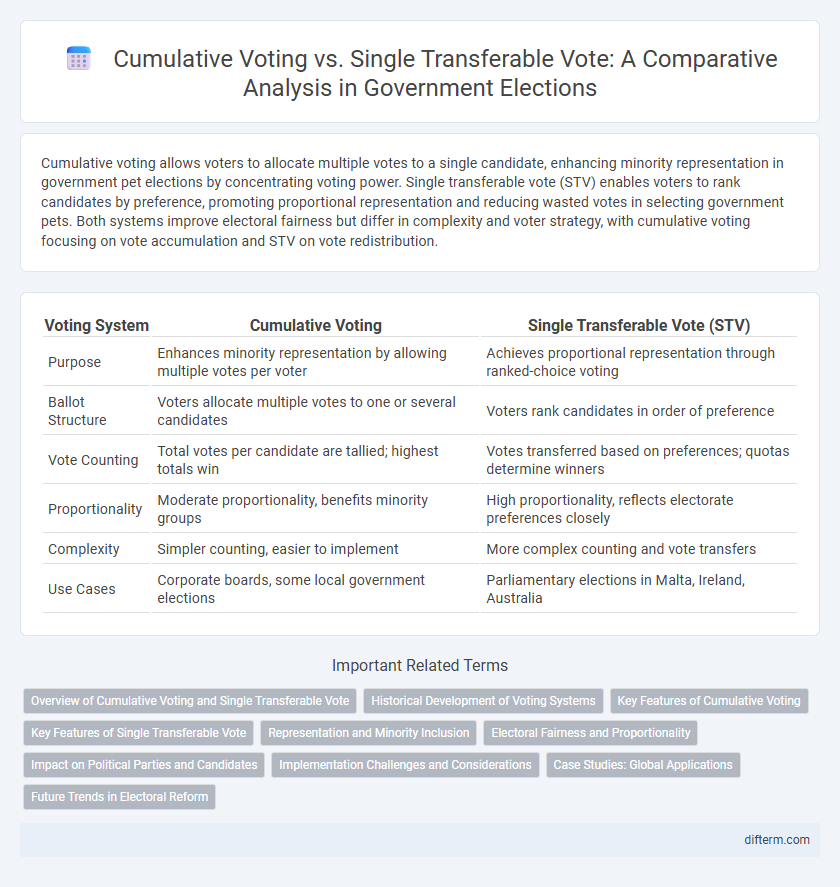Cumulative voting allows voters to allocate multiple votes to a single candidate, enhancing minority representation in government pet elections by concentrating voting power. Single transferable vote (STV) enables voters to rank candidates by preference, promoting proportional representation and reducing wasted votes in selecting government pets. Both systems improve electoral fairness but differ in complexity and voter strategy, with cumulative voting focusing on vote accumulation and STV on vote redistribution.
Table of Comparison
| Voting System | Cumulative Voting | Single Transferable Vote (STV) |
|---|---|---|
| Purpose | Enhances minority representation by allowing multiple votes per voter | Achieves proportional representation through ranked-choice voting |
| Ballot Structure | Voters allocate multiple votes to one or several candidates | Voters rank candidates in order of preference |
| Vote Counting | Total votes per candidate are tallied; highest totals win | Votes transferred based on preferences; quotas determine winners |
| Proportionality | Moderate proportionality, benefits minority groups | High proportionality, reflects electorate preferences closely |
| Complexity | Simpler counting, easier to implement | More complex counting and vote transfers |
| Use Cases | Corporate boards, some local government elections | Parliamentary elections in Malta, Ireland, Australia |
Overview of Cumulative Voting and Single Transferable Vote
Cumulative voting allows voters to allocate multiple votes to one or more candidates, enabling minority representation in multi-winner elections, while single transferable vote (STV) uses ranked preferences to transfer surplus and eliminated candidates' votes, ensuring proportional representation. Cumulative voting is simpler and often used in corporate or local government settings, whereas STV is more complex and preferred in parliamentary elections for its proportional accuracy. Both systems aim to enhance voter choice and fairer representation compared to traditional plurality voting.
Historical Development of Voting Systems
Cumulative voting originated in the late 19th century as a method designed to enhance minority representation in corporate and municipal elections by allowing voters to allocate multiple votes to one candidate. The single transferable vote (STV) emerged earlier in the 19th century, gaining prominence through its adoption in various Irish and Australian elections, ensuring proportional representation by transferring surplus votes. Both systems reflect evolving democratic ideals, with cumulative voting targeting minority voices and STV emphasizing proportional outcomes in multi-member constituencies.
Key Features of Cumulative Voting
Cumulative voting allows voters to allocate multiple votes to a single candidate, enabling minority representation by concentrating support. This system enhances proportionality by giving voters flexibility in expressing preferences, unlike the single transferable vote which relies on ranking candidates and transferring surplus votes. Cumulative voting is often used in corporate and local government elections to empower minorities and reduce vote dilution.
Key Features of Single Transferable Vote
Single Transferable Vote (STV) is a proportional representation system that allows voters to rank candidates in order of preference, ensuring more accurate reflection of voter intentions in multi-member constituencies. Key features include the transfer of surplus votes from elected candidates to remaining candidates based on voter preferences, minimizing wasted votes and enhancing minority representation. STV promotes voter choice and accountability by enabling voters to influence the election of multiple candidates while reducing the likelihood of vote splitting.
Representation and Minority Inclusion
Cumulative voting allows minority groups to concentrate their votes on fewer candidates, increasing their chances of representation within government bodies. Single transferable vote (STV) promotes proportional representation by enabling voters to rank candidates, ensuring minority preferences are reflected in election outcomes. Both systems enhance minority inclusion, but STV typically yields more proportional and diverse legislative bodies.
Electoral Fairness and Proportionality
Cumulative voting enhances electoral fairness by allowing voters to allocate multiple votes to a single candidate, which benefits minority representation and ensures diverse voices. Single transferable vote (STV) achieves proportionality by enabling ranked voting and vote transfers, accurately reflecting voter preferences across multi-member districts. Both systems improve democratic inclusivity but differ in complexity and proportionality outcomes, with STV typically yielding more proportional results.
Impact on Political Parties and Candidates
Cumulative voting allows political parties and candidates to concentrate votes on fewer individuals, enhancing minority party representation and increasing candidate diversity within legislative bodies. Single transferable vote (STV) promotes proportional representation by enabling voters to rank candidates, encouraging coalition-building and reducing dominance by major parties. Both systems influence party strategies and candidate selection, with cumulative voting favoring strategic vote allocation and STV fostering broader appeal across the electorate.
Implementation Challenges and Considerations
Cumulative voting faces implementation challenges such as vote management complexity and potential vote dilution in multi-member districts, requiring robust voter education and transparent ballot design. Single transferable vote (STV) demands intricate vote counting procedures and accurate preference allocation, often necessitating sophisticated software and trained election officials. Both systems require careful consideration of district magnitude, ballot clarity, and legal frameworks to ensure voter understanding and maintain election integrity.
Case Studies: Global Applications
Countries like Ireland and Malta have successfully implemented the Single Transferable Vote (STV) system, enhancing proportional representation and voter satisfaction. In contrast, corporate governance in the United States demonstrates cumulative voting's effectiveness in minority shareholder representation and board diversity. Comparative studies reveal that STV tends to promote broader electoral inclusivity, while cumulative voting is preferred for ensuring minority voices in smaller, non-governmental elections.
Future Trends in Electoral Reform
Future trends in electoral reform emphasize increased adoption of cumulative voting and single transferable vote systems to enhance proportional representation and voter empowerment. Cumulative voting allows voters to allocate multiple votes to preferred candidates, boosting minority representation in local and corporate governance structures. Single transferable vote systems promote fairer election outcomes by enabling voters to rank candidates, ensuring that elected bodies more accurately reflect diverse political preferences and demographics.
cumulative voting vs single transferable vote Infographic

 difterm.com
difterm.com